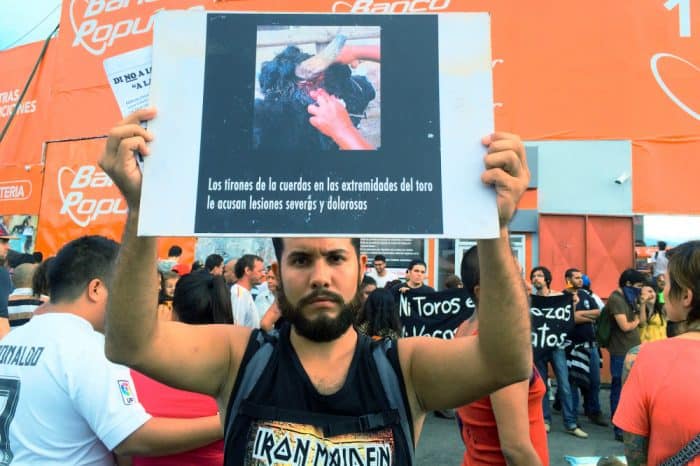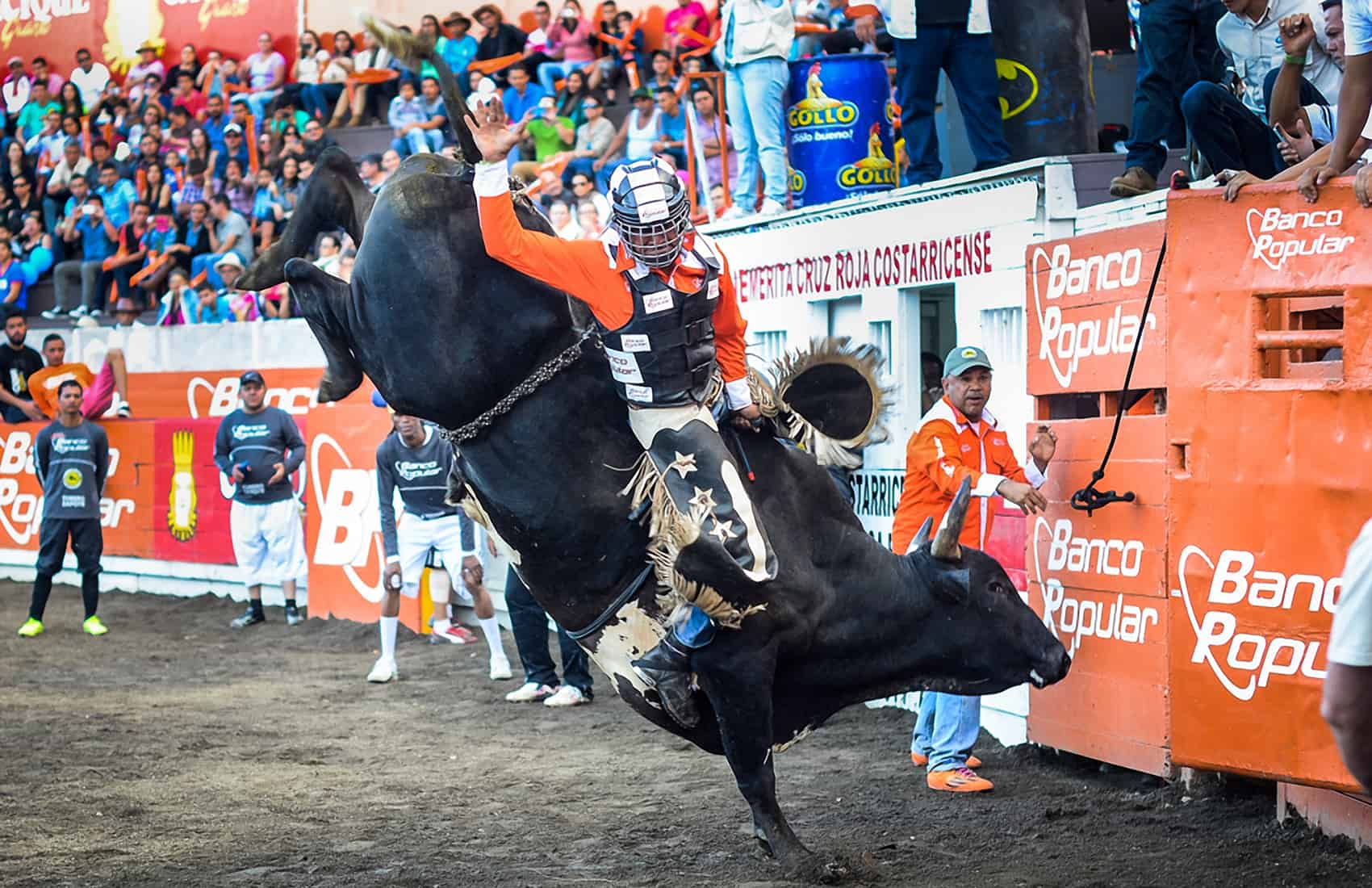The traditional Zapote Festival kicked off on Sunday; Tico-style bullfights are for many the main event, despite increasing disapproval of the practice.
A survey by the National University’s Institute for Social Studies (IDESPO) released earlier this month found that nearly half of respondents would favor a ban on bullfights in Costa Rica. Results showed a polarized population: 46.4 percent of respondents said they would support a ban, while 50.1 percent disagreed.
The investigation did not question people about the reasons for their answers. However, researchers concluded that supporters consider bullfights a Costa Rican tradition and don’t think they violate animal rights, while those who oppose the bullfights tend to consider them just another form of animal abuse. IDESPO conducted its survey of 800 people, with a margin of error of 3.5 percent.
For more information on the bulls’ experience at an event like the Zapote Festival and the regulations designed to protect them, The Tico Times spoke to animal rights leaders who criticize the practice, and a government official who argued that controls and veterinary supervision of the bullfights are strict and protect the animals.
Speaking out
Animal rights advocates have staged public demonstrations in front of the Zapote bullring in recent years, asking people to stop attending the shows and asking government officials for a ban on them.
Last year, demonstrators from five groups under the umbrella name “Coordinated Group for Animal Liberation” gathered in front of the bullring’s box offices. The group chanted slogans and displayed banners with messages about the suffering bulls go through before, during and after the fights.
The group has staged similar protests against bullfighting, the National Horse Parade, rodeos and zoos.
Among other complaints about Tico-style bullfights, demonstrators said bulls are crammed into a truck where they don’t receive any food or water. They defecate and urinate on each other, and travel exposed under the sun on the road for several hours, they argued.
One of the demonstrators, Andrea Brizuela, told The Tico Times during last year’s protest that bulls are taken to dark pens under the bullring where they are subjected to tail-twisting and get shocked with electric prods to make them aggressive. They are then sent into the bullring “where hundreds of people scream at them, hit them and pull their tails. Then [the bulls] are tied up and returned to the barns, and sometimes this results in their horns getting hurt and even broken,” she said.
Gerardo Huertas, director of Emergencies at World Animal Protection Costa Rica, told The Tico Times that all types of bullfighting should be banned. Huertas agrees with the description of the bulls’ experience provided by animal rights groups, and said the abuse begins as soon as bulls are taken from the farms. Bulls are provoked using electric prods delivering thousands of volts when they are about to leave their chutes.
“I consider their harassment to be as barbaric as a Roman circus,” Huertas said.
Bulls used for riding are kept in small spaces to make them anxious. Staffers use flank straps that are painfully tightened around the bull’s body and near their genitalia to encourage bucking, he said. Riders wear spurs that hurt the bull’s skin.
“It’s clear that they are in pain. No bull in its natural habitat jumps and runs like they do at a bullfight,” he stated.
However, he noted that the situation is less severe at the Zapote Festival than at less popular events, as there is increased supervision from government officials. Television cameras also discourage people from hurting bulls, he added.
“But the situation in bullfights taking place all over the country is serious. Bulls are subjected to a lot of suffering all year round,” he said.

Government regulations
Warren Hidalgo Jara, an Agriculture & Livestock Ministry (MAG) veterinarian, told The Tico Times that current controls over bullfights are very strict.
Hidalgo, who is the National Animal Health Service (SENASA) coordinator of the Livestock Welfare Program, said bull fighting is regulated by Executive Decree #19,183, which provides a series of requirements and regulations for authorizing a bullfighting event. He explained that livestock producers that provide bulls for the fights must obtain a SENASA license that certificates the proper transport and handling of the animals. Event organizers also are required to obtain a license granted after an inspection of the bullring facilities.
MAG and the Health Ministry must also grant a third license for the event after evaluating safety requirements for spectators and the animals.
Hidalgo said SENASA’s law includes regulations for bull riders and for bullfighters. Rules include precise descriptions of the chutes, ropes, spurs and other devices used in bullfights.
Spurs used in most rodeos worldwide are banned here, and SENASA only allows straight 7-millimeter (1⁄4 inch) spurs. Regulations also require a veterinarian be present at all bullfights. The vet must supervise the whole process starting with the bulls’ arrival from the farms, the bull’s return to the barn and into the truck, Hidalgo said.
During the bullfights, vets monitor the appropriate use of electric prods, straps and spurs.
“Veterinarians must ensure total compliance with SENASA’s laws and also with regulations from the Costa Rica’s Association of Veterinarians,” he said. Regulations for electric prods, for example, only allow the use of battery-operated prods and forbid people from giving shocks to sensitive body parts such as the bull’s head or his genitalia.
Vets are also required to check the type and length of spurs and also verify that they are disinfected every time they are to be used. SENASA’s regulations also require festival organizers to submit a script of all bullfights describing what kind of shows will be presented each day.
Besides Tico-style bullfights, shows at the Zapote Festival include rodeo competitions, clowns, and even Spanish-style bullfighting, altough killing the bull is not allowed in Costa Rica.
The vet checks daily programs in order to prevent events that could pose a risk to the bulls.
“Veterinarians have the authority to stop a bullfight at any moment if they determine that the bull is being abused,” Hidalgo said.
Abuse not only can provoke the suspension of the show; it also entails monetary fines to every person found guilty and to the bullfight organizers. Fines range from 7 to 50 base salaries, equivalent to ₡3-₡21 million ($5,300-37,600).
An Animal Welfare bill currently at a stalemate at the Legislative Assembly seeks to increase those fines and even set prison sentences for those found guilty of hurting or killing an animal. The proposed bill allows Tico-style bullfights, but it calls for stricter supervision measures and protection for the bulls.

